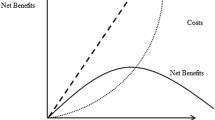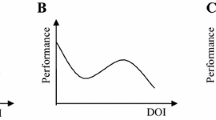Abstract
We focus on the relationship between internationalization choices and performance of Italian firms during the first period of the financial crisis (2007–2010). Making use of a new firm-level database, we build a six-class taxonomy of firms’ internationalization activities; then we estimate firms’ performance as a function of internationalization forms, also estimating propensity score and Heckman selection models in order to control for endogeneity and sample selection bias. Over the period 2007–2010, Italian firms moved (on average) towards more complex forms of internationalization. Empirical analysis finds that these upward changes are related with positive effects on firms’ (labour) productivity, also in a period characterized by the 2009 trade collapse. These findings put additional emphasis on the issue of the diversification of both products and markets as a goal to be pursued by firms, even in times of crisis, to remain competitive and make profits.
Similar content being viewed by others
Notes
Net movements of small and medium sized firms along internationalization classes are tested as follows: firstly, we calculate the transition matrix of Table 3 for small and medium sized firms; then, we run two-sample test of the incidence of SMEs across internationalization forms. The empirical evidence shows that the transitions of SMEs between 2007 and 2010 are statistically significant in the case of two-way traders (as an increase) and only importer classes (as a decrease). Results are available on request.
Cash flow is defined as the sum of funds from operations, decreases in inventories, decreases in receivables, and increases in payables.
Moreover, according to the confidence indicators, on the one hand most entrepreneurs thought that the recession would be transitory, so that in the aftermath of the crisis most of them reacted by trying to maintain the current employment level, also using the instruments provided by the Italian labour law (e.g. the “Cassa Integrazione Guadagni”). On the other hand, households kept their consumption levels basically unchanged, also decreasing their saving rates. For a detailed analysis on these developments see ISTAT (2011).
In what follows, a caveat must be bore in mind: following the assumptions of the Italian business register, a firm is localized according to the region where it has its headquarters, even if some units (especially the larger-sized ones) may have plants located in several regions. Therefore, any consideration on the geographical effects of firms’ internationalization refers to the region where that firm has its headquarters.
The world market is divided into 11 areas: European Union 27; non-EU European countries, North Africa, other African countries, North America, Central and South America, Middle East, Central Asia, East Asia, Oceania, Other territories and destinations.
The number of products is computed according to the 8-digit code of the Combined Nomenclature (CN), the classification system adopted in the COE database.
References
Altomonte, C., Aquilante, T. & Ottaviano, G. I. P. (2012). The triggers of competitiveness: The EFIGE cross-country report. Bruegel Blueprint n.17.
Altomonte, C. & Békés, G. (2010). Trade complexity and productivity. CeFiG Working Papers 12, September.
Amatori, F., Bugamelli, M. & Colli, A. (2011). Italian firms in history: Size, technology and entrepreneurship economic history. Working Papers n.13, October, Banca d’Italia.
Amiti M. & Weinstein D.E. (2011) Exports and Financial Shocks. The Quarterly Journal of Economics, Oxford University Press, 126(4), 1841–1877. DOI: 10.1093/qje/qjr033.
Bellone, F., Musso, P., Nesta, L., & Schiavo, S. (2010). Financial constraints and firm export behaviour. The World Economy, 33(3), 347–373. doi:10.1111/j.1467-9701.2010.01259.x.
Benfratello, L. & Razzolini, T. (2008). Firm’s productivity and internationalisation choices: Evidence from a large sample of Italian firms. Development Studies Working Papers n. 236, Centro Luca D’Agliano.
Bernard, A. B., & Jensen, J. B. (1995). Exporters, jobs and wages in U.S. manufacturing: 1976–1987. Brookings Papers on Economic Activity, Microeconomics, 1, 67–119. doi:10.2307/2534772.
Bernard, A. B., Redding, S. J., & Schott, P. K. (2011). Multi-product firms and trade liberalization. Quarterly Journal of Economics, 126(3), 1271–1318. doi:10.1093/qje/qjr021.
Blundell, R. & Costa Dias M. (2002). Alternative approaches to evaluation in empirical microeconomics. Cemmap Working Paper 10/02.
Bricogne, J. C., Fontagne, L., Gaulier, G., & Taglioni, D. (2012). Firms and the global crisis: French exports in the turmoil. Journal of International Economics, 87(1), 134–146. doi:10.1016/j.jinteco.2011.07.002.
Bugamelli, M., Cipollone, P., & Infante, L. (2000). L’internazionalizzazione delle imprese italiane negli anni ‘90. Rivista Italiana degli Economisti, SIE—Società Italiana degli Economisti, 5(3), 349–386.
Caliendo M. & Köpeinig S (2005) Some practical guidance for the implementation of propensity score matching. IZA Discussion Paper 1588.
Castellani, D., Serti, F., & Tomasi, C. (2010). Firms in international trade: Importers’ and exporters’ heterogeneity in the Italian manufacturing industry. The World Economy, 33(3), 424–457. doi:10.1111/j.1467-9701.2010.01262.x.
Chaney T. (2005). Liquidity constrained exporters, mimeo.
Chaney, T. (2008). Distorted gravity: The intensive and extensive margins of international trade. American Economic Review, 98, 1707–1721. doi:10.1257/aer.98.4.1707.
Chor, D., & Manova, K. (2012). Off the cliff and back? Credit conditions and international trade during the global financial crisis. Journal of International Economics, 87(1), 117–133. doi:10.1016/j.jinteco.2011.04.001.
Coulibaly, B., Sapriza, H., & Zlate, A. (2011). Trade credit and international trade during the 2008–09 global financial crisis (p. 1020). International Finance Discussion Papers: Federal Reserve Board, no.
Cristadoro, R. & D’Aurizio, L. (2015). Le caratteristiche principali dell’internazionalizzazione delle imprese italiane. Quaderni di economia e Finanza, n.261, Marzo, Banca d’Italia.
Del Prete S. & Federico S.(2014). Trade and Finance: is there more than just “trade finance”? Evidence from matched bank-firm data. Temi di Discussione Banca d’Italia, n.948, January.
Eaton J., Kortum S., Nieman B. & Romalis J. (2011). Trade and global recession. Working paper Research 196, National Bank of Belgium.
Egger, P., & Kesina, M. (2014). Financial constraints and intensive and extensive margins of firm exports: Panel data evidence from China. Review of Development Economics, 18(4), 625–639. doi:10.1111/rode.12107.
Fabiani, S. & Zevi, G. (2014). L’esposizione internazionale e l’evoluzione delle imprese manifatturiere italiane negli anni della crisi. Mimeo, Banca d’Italia.
Feenstra, R. C., Li, Z., & Yu, M. (2014). Exports and credit constraints under incomplete information: Theory and evidence from China. Review of Economics and Statistics, 96(4), 729–744. doi:10.1162/REST_a_00405.
Greenaway, D., Guariglia, A., & Kneller, R. (2007). Financial factors and exporting decisions. Journal of International Economics, 73(2), 377–395. doi:10.1016/j.jinteco.2007.04.002.
Heckman, J. (1979). Sample selection bias as a specification error. Econometrica, 47, 153–161. doi:10.2307/1912352.
ISTAT (2011). Rapporto Annuale. Rome.
Levchenko, A., Lewis, L., & Tesar, L. (2010). The collapse of international trade during the 2008–2009 crisis. In search of the smoking gun. IMF. Economic Review, 58(2), 214–253. doi:10.1057/imfer.2010.11.
Manova, K. (2013). Credit constraints, heterogeneous firms and international trade. The Review of Economic Studies, 80, 711–744. doi:10.1093/restud/rds036.
Melitz, M. J. (2003). The impact of trade on intra-industry reallocations and aggregate industry productivity. Econometrica, 71(6), 1695–1725. doi:10.1111/1468-0262.00467.
Melitz, M. J., & Ottaviano, G. I. P. (2008). Market size, trade, and productivity. Review of Economic Studies, 75(1), 295–316. doi:10.1111/j.1467-937X.2007.00463.x.
Minetti, R., & Zhu, S. C. (2011). Credit constraints and firm export: Microeconomic evidence from Italy. Journal of International Economics, 83(2), 109–125. doi:10.1016/j.jinteco.2010.12.004.
Muuls M. (2008), Exporters and credit constraints. A firm-level approach, National Bank of Belgium Working Papers, no. 139.
Muuls, M., & Pisu, M. (2009). Imports and exports at the level of the firm: Evidence from Belgium. The World Economy, 32(5), 692–734. doi:10.1111/j.1467-9701.2009.01172.x.
Paauwe, J. (2004). HRM and performance; achieving long term viability. Oxford: Oxford University Press.
Paravisini D., Rappoport V., Schnabl P. & Wolfenzon D. (2011). Dissecting the effect of credit supply on trade: Evidence from matched credit-export data. NBER Working Paper No. 16975.
Rajan, R., & Zingales, L. (1998). Financial dependence and growth. American Economic Review, 88(3), 559–586.
Wagner, J. (2012). International trade and firm performance: A survey of empirical studies since 2006. Review of World Economics, 148, 235–267. doi:10.1007/s10290-011-0116-8.
Wagner, J. (2014). Credit constraint and export; A survey of empirical studies using firm-level data. Industrial and Corporate Changes, 23(6), 1477–1492. doi:10.1093/icc/dtu037.
Wooldridge, J. (2002). Econometric analysis of cross section and panel data. Cambridge: MIT Press.
Author information
Authors and Affiliations
Corresponding author
Appendix: Dataset description
Appendix: Dataset description
Our dataset is obtained through the integration of four firm-level datasets. The reference statistical source is given by the ISTAT structural business statistics surveys (SBS), providing information on firms’ structure (e.g. size, sectors, value of production, turnover, value added). Currently, they include all the companies with at least 100 employees (the so-called SCI survey) and a large “rotating” sample of firms with less than 100 employees (PMI). PMI datasets essentially includes the variables appearing in the firm’s income statement but not those from the balance sheet statement.
Firm-level trade data are drawn from custom trade statistics (COE). COE is a census type statistics (based on administrative data) and represents a harmonized source of data about imports, exports and trade balance. It collects information on firms operating in Italy and tracks the value and quantity of goods traded by Italian firms with both EU (intra-EU trade) and non-EU operators (extra-EU trade). Specifically, for each firm and time period, COE contains information on the value and the volume of goods traded (exported and imported) by each pair of product/destination market.
We manage this information as follows. First, origin/destination markets are grouped into 11 geographical areas.Footnote 6 Second, export/import flows by firm/destinations/origin are aggregated with respect to firm’s scope, so that only the information on the number of products by firm/destination/origin market is retained.Footnote 7 Overall, the revised structure of COE dataset is as follows: (i) firm-level exports/imports towards/from 11 specific destination/origin areas are available; (ii) the number of product exported is provided for each pair of firm/destination markets.
Information about multinational firms is provided by FATS database, that reports firm-level data on both the foreign-controlled enterprises operating in Italy (inward FATS statistics) and Italian non-resident foreign affiliates (outward FATS statistics). It is worth noticing that, merging FATS and COE datasets, we include in our dataset only multinational firms located within national boundaries, i.e., Italian firms with foreign affiliates and foreign-owned branch operating in Italy.
The firm-level matching of the information contained in the above statistical sources is achieved using the ISTAT Business Register (BR) that present a unique association between the ISTAT “company code” and firm’s VAT code.
The dataset used for the empirical analysis consists of matched firm-level information for two separate periods, 2007 and 2010, denoting, respectively, the beginning of the global financial crisis and a temporary recovery of the business cycle. For each year, it includes more than 90.000 statistical units. According to 2010 sample data, enterprises employed about 4.4 million workers and exported goods for about 293 billion of euros (over 85 % of total Italian exports).
Rights and permissions
About this article
Cite this article
Costa, S., Pappalardo, C. & Vicarelli, C. Internationalization choices and Italian firm performance during the crisis. Small Bus Econ 48, 753–769 (2017). https://doi.org/10.1007/s11187-016-9799-5
Accepted:
Published:
Issue Date:
DOI: https://doi.org/10.1007/s11187-016-9799-5




